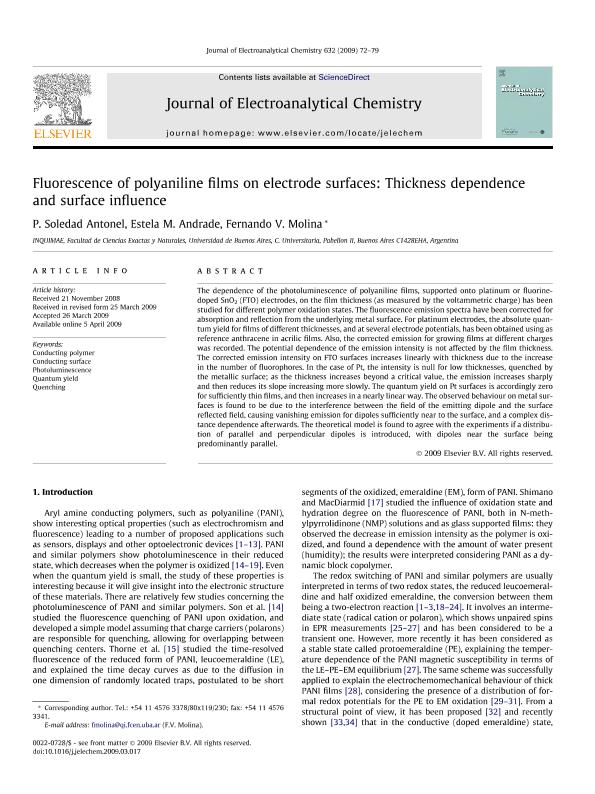Mostrar el registro sencillo del ítem
dc.contributor.author
Antonel, Paula Soledad

dc.contributor.author
Andrade, Estela María

dc.contributor.author
Molina, Fernando Víctor

dc.date.available
2019-03-22T17:11:33Z
dc.date.issued
2009-07
dc.identifier.citation
Antonel, Paula Soledad; Andrade, Estela María; Molina, Fernando Víctor; Fluorescence of polyaniline films on electrode surfaces: Thickness dependence and surface influence; Elsevier Science Sa; Journal of Electroanalytical Chemistry; 632; 1-2; 7-2009; 72-79
dc.identifier.issn
1572-6657
dc.identifier.uri
http://hdl.handle.net/11336/72305
dc.description.abstract
The dependence of the photoluminescence of polyaniline films, supported onto platinum or fluorine-doped SnO2 (FTO) electrodes, on the film thickness (as measured by the voltammetric charge) has been studied for different polymer oxidation states. The fluorescence emission spectra have been corrected for absorption and reflection from the underlying metal surface. For platinum electrodes, the absolute quantum yield for films of different thicknesses, and at several electrode potentials, has been obtained using as reference anthracene in acrilic films. Also, the corrected emission for growing films at different charges was recorded. The potential dependence of the emission intensity is not affected by the film thickness. The corrected emission intensity on FTO surfaces increases linearly with thickness due to the increase in the number of fluorophores. In the case of Pt, the intensity is null for low thicknesses, quenched by the metallic surface; as the thickness increases beyond a critical value, the emission increases sharply and then reduces its slope increasing more slowly. The quantum yield on Pt surfaces is accordingly zero for sufficiently thin films, and then increases in a nearly linear way. The observed behaviour on metal surfaces is found to be due to the interference between the field of the emitting dipole and the surface reflected field, causing vanishing emission for dipoles sufficiently near to the surface, and a complex distance dependence afterwards. The theoretical model is found to agree with the experiments if a distribution of parallel and perpendicular dipoles is introduced, with dipoles near the surface being predominantly parallel. © 2009 Elsevier B.V. All rights reserved.
dc.format
application/pdf
dc.language.iso
eng
dc.publisher
Elsevier Science Sa

dc.rights
info:eu-repo/semantics/openAccess
dc.rights.uri
https://creativecommons.org/licenses/by-nc-sa/2.5/ar/
dc.subject
Conducting Polymer
dc.subject
Conducting Surface
dc.subject
Photoluminescence
dc.subject
Quantum Yield
dc.subject
Quenching
dc.subject.classification
Otras Ciencias Químicas

dc.subject.classification
Ciencias Químicas

dc.subject.classification
CIENCIAS NATURALES Y EXACTAS

dc.title
Fluorescence of polyaniline films on electrode surfaces: Thickness dependence and surface influence
dc.type
info:eu-repo/semantics/article
dc.type
info:ar-repo/semantics/artículo
dc.type
info:eu-repo/semantics/publishedVersion
dc.date.updated
2019-03-21T16:13:17Z
dc.journal.volume
632
dc.journal.number
1-2
dc.journal.pagination
72-79
dc.journal.pais
Países Bajos

dc.journal.ciudad
Amsterdam
dc.description.fil
Fil: Antonel, Paula Soledad. Consejo Nacional de Investigaciones Científicas y Técnicas. Oficina de Coordinación Administrativa Ciudad Universitaria. Instituto de Química, Física de los Materiales, Medioambiente y Energía. Universidad de Buenos Aires. Facultad de Ciencias Exactas y Naturales. Instituto de Química, Física de los Materiales, Medioambiente y Energía; Argentina
dc.description.fil
Fil: Andrade, Estela María. Consejo Nacional de Investigaciones Científicas y Técnicas. Oficina de Coordinación Administrativa Ciudad Universitaria. Instituto de Química, Física de los Materiales, Medioambiente y Energía. Universidad de Buenos Aires. Facultad de Ciencias Exactas y Naturales. Instituto de Química, Física de los Materiales, Medioambiente y Energía; Argentina
dc.description.fil
Fil: Molina, Fernando Víctor. Consejo Nacional de Investigaciones Científicas y Técnicas. Oficina de Coordinación Administrativa Ciudad Universitaria. Instituto de Química, Física de los Materiales, Medioambiente y Energía. Universidad de Buenos Aires. Facultad de Ciencias Exactas y Naturales. Instituto de Química, Física de los Materiales, Medioambiente y Energía; Argentina
dc.journal.title
Journal of Electroanalytical Chemistry

dc.relation.alternativeid
info:eu-repo/semantics/altIdentifier/url/https://www.sciencedirect.com/science/article/pii/S0022072809001144
dc.relation.alternativeid
info:eu-repo/semantics/altIdentifier/doi/https://doi.org/10.1016/j.jelechem.2009.03.017
Archivos asociados
